Catherine Carvell, author of the upcoming Darcy Moon and the Deep-Fried Frogs, was interviewed by Emily Lim, author of many, many picture books including Prince Bear & Pauper Bear, A New Home for Kai Kai and Jia Jia, and Tibby the Tiger Bunny for the NBDCS blog.
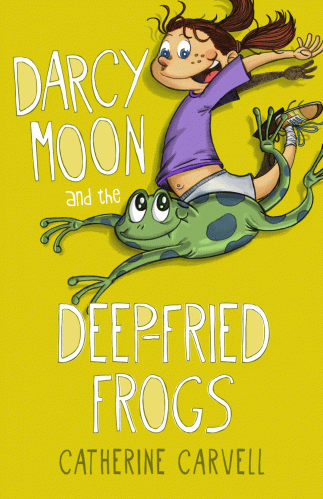
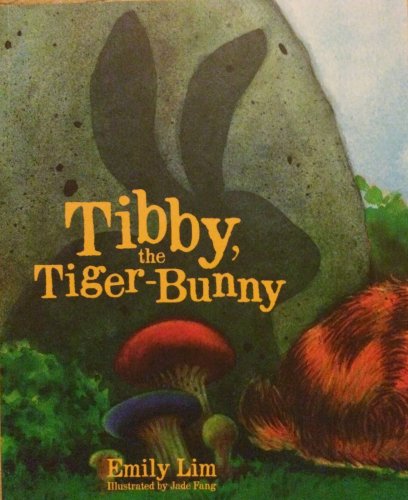
Emily: Catherine, congratulations on the upcoming release of your debut novel Darcy Moon in March 2014! I hear that Fremantle Press has already pre-sold 2500 copies to the Library Association in Australia?
First, tell us how you feel about all that!
Catherine: Well, as you can imagine I’m thrilled. Not only does it mean that the School Library Association believe Darcy Moon and the Deep-Fried Frogs will be a valuable addition to their libraries, but it’s so exciting to know that kids all over Australia will have such easy access to my story. I mean, what better place for a book to be than in your school library?
Emily: Next, tell us where you found the inspiration for the book.
Catherine: I’ve always loved writing. I wanted to be an author when I was seven. I’ve always loved nature too. I remember when I was seven years old arriving home from school with my arms covered in snails. I thought they would make good pets but my mother didn’t agree. I also had a collection of earthworms which I fed every day, and watched them turn leaves into beautiful rich soil. Even as I grew older I was still torn between my two passions. I studied a Bachelor of Environmental Science and then a Post-Graduate Diploma in Journalism. So I suppose I was always going to write an environmental story of some sort. This one sort of evolved. My children were very small, and through reading to them I was reminded of my childhood dream to be an author, and decided to write a book for the little girl I used to be. I created Darcy Moon (a tomboy girl with a special affinity with nature) and the rest followed.
Emily: And finally, give us a glimpse into what the book is about.
Catherine: Darcy Moon's biggest worry is her mum's hairy armpits. But when a spooky old turtle asks her for help, it looks like she might have to save the swamp as well. What follows is slime filled adventure full of freaked out frogs, evil villains, and remarkably tasty potato chips. Heartwarming, action-packed and full of laughs Darcy Moon and the Deep-Fried Frogs is an easy-read romp with environmental themes, for children aged 7 and up.
Emily: Last year, you were the Pitch Award Winner at SCBWI’s Rottnest Retreat in Australia for your idea for Darcy Moon, which is now a book. What did that award mean to you? What does the Rottnest Retreat mean to you given that you flew back to be a part of it even after relocating to Singapore?
Catherine: Rottnest island is one of my favourite places on earth, and the SCBWI retreaters are some of my all time favourite people. They’ve supported and encouraged me since 2010 and many have become my close friends. It was wonderful to receive the award in such beautiful natural surroundings, and to celebrate my first ever publication deal with the best cheer squad in the world.
Emily: You come from a journalism background. How different has it been from that and writing a children’s novel? How much of your journalistic hat has helped and not helped in this genre of writing?
Catherine: Adult readers will often trudge through a dull newspaper article (or a book) in order to learn some important piece of information contained within it. Children, however, will not. I think as a children’s author it is okay to explore important issues (like the impact of humans on the environment), but first and foremost children’s fiction is about writing a fast paced, funny and exciting story, which keeps a child engaged. If your story doesn’t do that it simply won’t get read, no matter how important its underlying message.
Emily: Tell us how you found your publisher. How many rewrites were involved to reach final copy and how long it took?
Catherine: I started writing Darcy Moon and the Deep-Fried Frogs in 2008 when my youngest child was only 6 months old. In mid 2010, I completed my first manuscript. It had taken me two years and more rewrites than I can count. I attended the 2010 WA SCBWI Rottnest Retreat and paid a visiting editor to critique the first 10 pages of my manuscript. Her feedback was invaluable, and I realised I had a long way to go before my manuscript would be anyway near publishable. But I didn't have time to dwell on things, because soon after, we discovered we were moving to Singapore. With two children under 5, the move kept me busy and when I picked up my manuscript six months later, I was able to see it with fresh eyes. I knew exactly where I needed to make changes. I rewrote the whole thing. In the mean time, I had joined the Singapore SCBWI group and was happy to find they met every month to discuss all things writerly in Singapore, and critique each others' work. Fantastic!
I kept writing, and kept getting feedback through every avenue I could access (competitions, conferences, panels, peers) and eventually, by early 2012. I had a manuscript I was happy with. So then I started researching publishers. Were they accepting unsolicited manuscripts? What sort of titles did they publish? All that stuff. Scary. Fremantle Press were accepting manuscripts by West Australian Authors or with West Australian content and setting. And they had a strong children's section, which included mid grade. My manuscript seemed like the perfect fit. So I sent it off.
And 7 weeks later I got a 'we would like to publish your manuscript' email. It was a miracle! Albeit, a miracle five years in the making.
Emily: You were/are a member of SCBWI Western Australia before relocating to Singapore with your family. How different has it been for you being part of SCBWI WA compared to SCBWI Singapore which is quite newly formed?
Catherine: The main difference is that members in Singapore are not separated by long distances and travel, so we are able to meet more often. Which is fantastic!
Emily: You were one of the earliest members for SCBWI Singapore, right? As coordinator (what’s the correct word?) for SCBWI Singapore, tell us briefly how the SCBWI meetings are run.
Catherine: The SCBWI Singapore group is growing rapidly. When I arrived in Singapore in 2010 we had 5 members and now we have over 40! Several of our members have been published multiple times, while others are just starting on their writing journey. We also have some amazing illustrators in the group as well. We meet once a month to critique each other’s work, encourage each other and talk about all things writerly. We have host dinners for international authors when they come to Singapore. So far we have had the pleasure of meeting Wendy Orr, Jacqueline Harvey, Lisa Yee and Linda Sue-Park.
Emily: Are you working on any stories at this time? Can you give us a sneak peek into that?
Catherine: I’m always working on stories. I’m trying to write a picture book at the moment and I don’t know how you do it, Emily. So few words and yet so difficult to write! I’m also working on another novel. It’s the story of two friends who discover a strange and wounded creature trapped in the mangroves. And of course, there’s always the next Darcy Moon adventure!
Emily: As a writer coming from Australia, how similar or different do you see the Singapore market in comparison. How has it made a difference in your writing, if any?
Catherine: No matter where a kid lives, they all love fascinating stories filled with adventure, emotion and interesting characters. And while it is true that different publishers fill different niches in the market (Australian publishers often want Australian content while Singapore based publishers prefer stories based in Singapore or Asia), I don’t ever think about this when I am writing.
A believe a writer’s job is to tell a story and tell it well. And that is what I try to do.
-----
Thanks to both Catherine and Emily for taking the time out of their very busy schedules for this interview. You can find out more about Emily Lim by visiting her blog at mummumstheword.wordpress.com, and you can find out more about Catherine Carvell by visiting her webpage at www.catherinecarvell.com.
Of Asia and Children’s Books: The Role of the Asian Festival of Children’s Content (AFCC)
Featuring R. Ramachandran, Executive Director of AFCC,
and Bolormaa Baasansuren and Ganbaatar Ichinnorov, SingTel Asian Picture Book Award Winners for Old City
on Friday, January 10, 2014
Contributed by the SCBWI Japan Blog Editorial Team
Photos by Annie Donwerth Chikamatsu
When we received an email from R. Ramachandran that he would visit Tokyo in January, we were all excited, for he is not only the Executive Director of National Book Development Council of Singapore, he is also the Executive Director of the Asian Festival of Children’s Content (AFCC). He is a highly regarded librarian who has received numerous accolades for his work in promoting literacy.
Always held in Singapore, AFCC’s vision has been to provide the world’s children with high-quality Asian content so that they may learn about Asian cultures through multimedia. Its mission is to foster excellence in creation, production, publication and promotion of children’s materials in Asia since 2010, and for a decade before while the festival went under the name of Asian Children’s Writers and Illustrators Conference (ACWIC). The number of faculty, participants and attendees has grown over the years, and the festival’s workshops, exhibitions and media mart attract preschool and primary school teachers, parents, writers and illustrators, librarians and media specialists (producers, publishers, etc.), providing them a place to learn and to share ideas and materials about the region. The country of focus for 2014 is India, and the conference features a line-up of experts and authors from India and beyond.
Many SCBWI Japan members have presented at past festivals; our very own Holly Thompson, Regional Advisor of SCBWI Japan, and Naomi Kojima, Illustrator Coordinator, gave keynote speeches for the 2013 AFCC, while Alexander O. Smith (publisher and translator), Avery Fischer Udagawa (translator), Yoko Yoshizawa (illustrator), and Trevor Kew (writer) gave presentations on various aspects of children’s book publishing in past festivals. Mariko Nagai, the Assistant Regional Advisor, has been invited to present and launch her book at the 2014 AFCC.
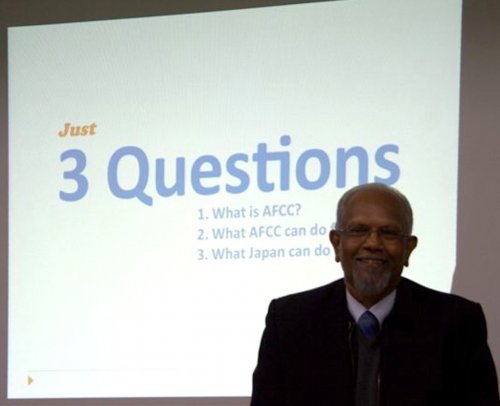
In his 45-minute presentation, Ramachandran emphasized again and again that Asian children often grow up reading books from Europe and America, and that there is more need to offer affordable and accessible Asian-themed books to children in Asia. In the past, when the festival was called ACWIC and only writers and illustrators participated, “nothing happened”, he said, though it was a great opportunity for writers and illustrators to gather and celebrate their works. By bringing teachers, parents, writers and illustrators, librarians and media specialists together, they can create practical synergy to the entire publishing process—from inspiration to publication to distribution and promotion. He shared with the audience several publications that resulted from the AFCC festivals, and emphasized that AFCC is interested in providing bilingual (English being one of the languages) high-quality yet affordable and accessible books with Asian content. The audience—one of the biggest SCBWI Japan has had—was composed of Japanese writers, illustrators, editors, librarians, and people from book-related museums and foundations who were eager to hear about opportunities at AFCC. After the presentation, we had time for Q&A, when various questions were asked—from the definition of “Asia,” to the economics of publishing and distribution, to translation, to English as lingua franca.
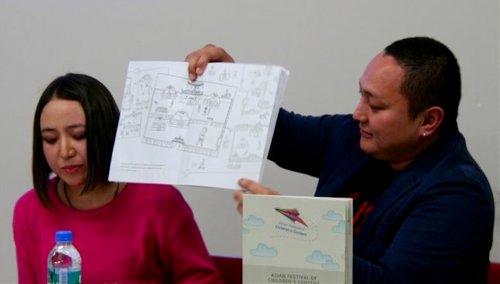
AFCC hosts the Scholastic Asian Book Award for authors of Asian descent, and the SingTel Picture Book Award is open to picture books depicting an Asian theme from authors and illustrators worldwide. Bolormaa Baasansuuren and Ganbaatar Ichinnorov, the husband-and-wife writer and illustrator winners of the 2013 SingTel Picture Book Award, presented their picture book, Old City. Moving from illustration to illustration, the book provides a wonderful journey into the past from present-day urbanization. Bolormaa and Ganbaatar shared the story of when they first conceived the idea back in 2006. At that time, they did not know how to write a children’s book, but with the helpful feedback from SCBWI Japan (namely, Holly Thompson and John Shelley), they rewrote the book. We had the pleasure to see the dummy that was submitted to the award, as well as hear them talk about their process of working both together and individually on this book. Their talk was done in Mongolian, which was first translated into Japanese, then into English. It indeed embodied the international spirit of SCBWI and the event itself!
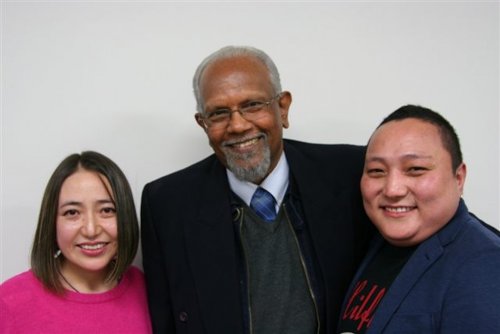
Overall, it was a wonderful night of insights, inspiration, networking, and laughter.
This year’s AFCC will take place in the National Library Building in Singapore from May 30 to June 4, 2014. For further information about the Asian Festival of Children’s Content see AFCC.com.sg






